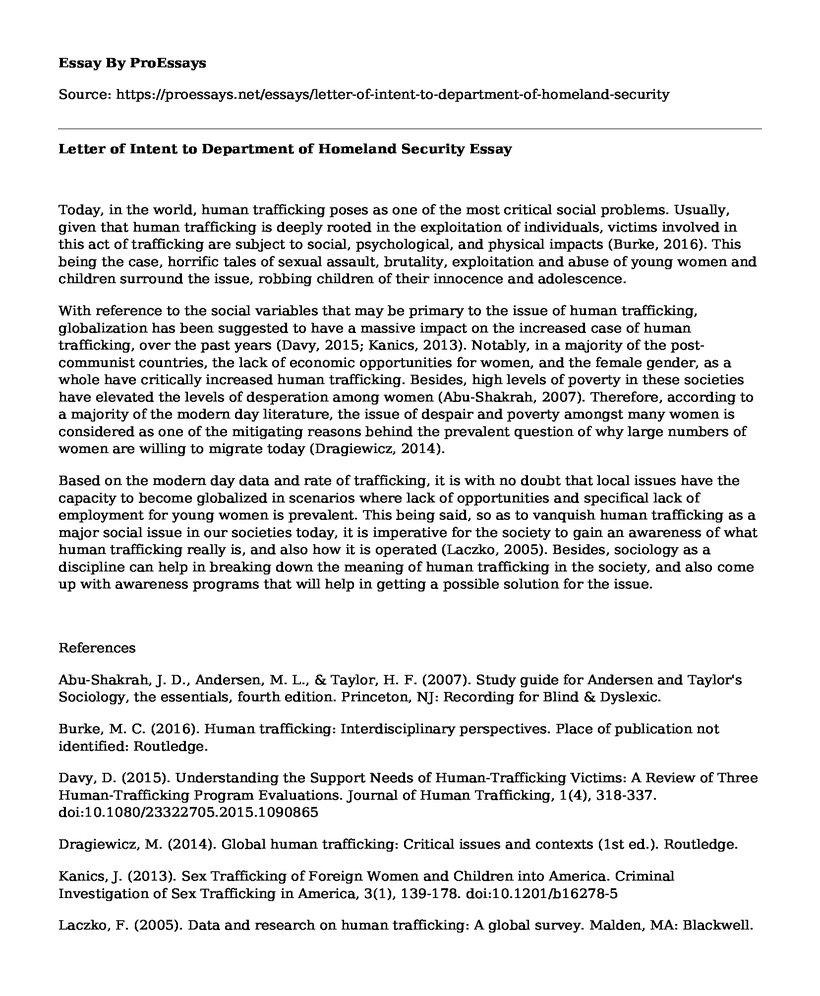Today, in the world, human trafficking poses as one of the most critical social problems. Usually, given that human trafficking is deeply rooted in the exploitation of individuals, victims involved in this act of trafficking are subject to social, psychological, and physical impacts (Burke, 2016). This being the case, horrific tales of sexual assault, brutality, exploitation and abuse of young women and children surround the issue, robbing children of their innocence and adolescence.
With reference to the social variables that may be primary to the issue of human trafficking, globalization has been suggested to have a massive impact on the increased case of human trafficking, over the past years (Davy, 2015; Kanics, 2013). Notably, in a majority of the post-communist countries, the lack of economic opportunities for women, and the female gender, as a whole have critically increased human trafficking. Besides, high levels of poverty in these societies have elevated the levels of desperation among women (Abu-Shakrah, 2007). Therefore, according to a majority of the modern day literature, the issue of despair and poverty amongst many women is considered as one of the mitigating reasons behind the prevalent question of why large numbers of women are willing to migrate today (Dragiewicz, 2014).
Based on the modern day data and rate of trafficking, it is with no doubt that local issues have the capacity to become globalized in scenarios where lack of opportunities and specifical lack of employment for young women is prevalent. This being said, so as to vanquish human trafficking as a major social issue in our societies today, it is imperative for the society to gain an awareness of what human trafficking really is, and also how it is operated (Laczko, 2005). Besides, sociology as a discipline can help in breaking down the meaning of human trafficking in the society, and also come up with awareness programs that will help in getting a possible solution for the issue.
References
Abu-Shakrah, J. D., Andersen, M. L., & Taylor, H. F. (2007). Study guide for Andersen and Taylor's Sociology, the essentials, fourth edition. Princeton, NJ: Recording for Blind & Dyslexic.
Burke, M. C. (2016). Human trafficking: Interdisciplinary perspectives. Place of publication not identified: Routledge.
Davy, D. (2015). Understanding the Support Needs of Human-Trafficking Victims: A Review of Three Human-Trafficking Program Evaluations. Journal of Human Trafficking, 1(4), 318-337. doi:10.1080/23322705.2015.1090865
Dragiewicz, M. (2014). Global human trafficking: Critical issues and contexts (1st ed.). Routledge.
Kanics, J. (2013). Sex Trafficking of Foreign Women and Children into America. Criminal Investigation of Sex Trafficking in America, 3(1), 139-178. doi:10.1201/b16278-5
Laczko, F. (2005). Data and research on human trafficking: A global survey. Malden, MA: Blackwell.
Cite this page
Letter of Intent to Department of Homeland Security. (2021, Jun 22). Retrieved from https://proessays.net/essays/letter-of-intent-to-department-of-homeland-security
If you are the original author of this essay and no longer wish to have it published on the ProEssays website, please click below to request its removal:
- The Barbie Doll and Female Beauty Standards - Essay Sample
- Essay Sample on Creating Safe Spaces: Exploring Eli Clare's Activism for Queer and Disabled People
- Unite and Heal: Resolving Political and Social Divides for a Better Nation - Essay Sample
- Police Officers: Recognizing Signs of Serial Killers - Essay Sample
- Essay Example on America's Indigenous Society: The Maya Civilization
- Essay Example on Workplace Violence: Understanding & Mitigating Factors
- Free Essay Sample: Cultivating Intercultural Understanding in Courtship and Marriage







